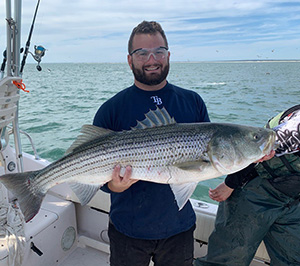Striped Bass
Latin Name: Marone Saxatillis
General Characteristics and Habitat
The striped bass is a wonderfully evolved creature. It has a large mouth with an under-slung jaw. Three rows of short teeth in the jaw with an additional two rows on its tongue. Most fish have seven dark stripes, but some have eight. 
Stripers are coastal fish, rarely found beyond three miles from land. Generally speaking, they seek rough, fast-moving water where hunting is easy. Their diet is wide-ranging, consisting of clupeids (herring and menhaden), spearing, eels, crab, clam, squid, seaworms, mollusks, blackfish, porgy, bluefish, flounder, bergalls, and more. Once on the fillet table, it is worthwhile, and interesting, to cut open the stomach to see what constituted its last meal. This helps in the selection of bait and/or lures to catch the next one.
Bass grow slowly but unlike mammals, they continue to grow the entire time they are alive. Currently, a bass must be at least 28 inches in length to keep for the table. This “min keeper” is between 5 and 7 years old and weighs about 12 pounds. I have personally seen a 60-pound fish caught and the world record currently stands at 81 pounds which was caught near Orient Point, NY.
Breeding and Migration
There are two primary breeding grounds: The Chesapeake Bay in Maryland and the Hudson River in New York, although spawning also occurs in tidal creeks and streams throughout the Northeast. Spawning occurs during the spring, beginning in April at the southernmost locations and concluding by the end of May in northern areas. Brackish or even freshwater both suffice. Female bass broadcast the eggs while surrounded by smaller males who provide the sperm. Within 48 hours larvae of about 3 millimeters in size hatch.

Penn Squall Lever Drag
Great all around inshore reel!
- Used by professionals worldwide
- Made with the highest quality components
- Tested for quality and durability
- Line Capacity: 25lb / 350y
About a week later the yolk sac has been consumed and the baby bass begins to swim and feed. Initially, the fish has no stripes, those take about 80 days to appear. A one-year-old bass is about 12 inches in length and weighs one pound. They are considered mature after three years; by that time they are about 20 inches in length and weigh five pounds, give or take.
How to Catch Them
My goodness! Where to begin? Just walk into any tackle shop then point at any piece of merchandise. Chances are excellent that whatever it is can be used to catch striped bass. Both spinning and conventional reels are used. Spinners are generally used with lures, while conventional reels are used for bait, but experienced anglers are adept at “mixing and matching”. Striped bass bait is also effective, see below.
A boat is the best place to be, but stripers are caught from the beach and many other places on land such as jetties such as those found at Shinnecock Inlet and a zillion other places.
A boat can be employed to drift, fish at anchor (typically while chumming) or to troll (pull lures behind a boat moving at 2 to 3 knots.
Eating
Striped bass meat is whitish with a mild flavor and a medium texture. Cooking isn’t even necessary as it can be eaten raw or pickled. However, most people prefer one or more of a wide range of preparations: Broiled, roasted, poached, pan-seared, steamed, grilled, sautéed, or deep-fried.
The Lingo
Rat: Any fish under about 20 inches in length
Schoolie: Fish between 20 and 27 inches
Nice Fish!: A fish measuring between 28 and 39 inches
Slob or Cow: Any fish over 40 inches. Interestingly, these fish are all females.
Fifty Pound Club Member: Any angler who has landed a fish 50 pounds or more.

